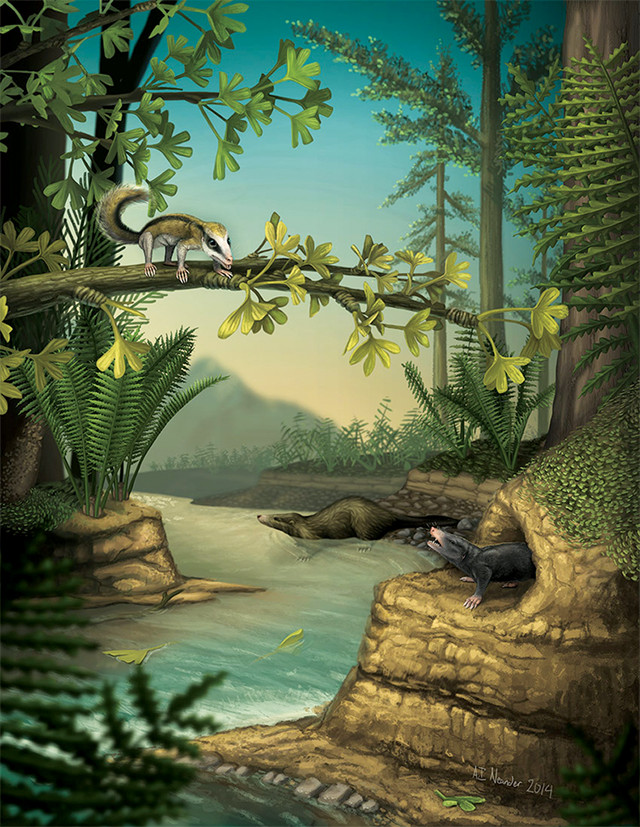
by Mary Caperton Morton Tuesday, October 6, 2015

Mammals, such as the docodonts illustrated here, experienced a burst of rapid evolution in skeletal and dental features in the Middle Jurassic. Credit: April Neander.
Dinosaurs dominated the continents during the Mesozoic, and for a long time, paleontologists assumed our mammalian ancestors kept a low-profile in that era, existing only as small, ground-dwelling, nocturnal insect-eaters. But in the last decade, discoveries of an ever-increasing diversity of mammal fossils have forced a rethink: Mesozoic mammals were also gliders, climbers, diggers and swimmers. Now, scientists looking at mammalian rates of evolution during the time of the dinosaurs have found that this diversity peaked in the Mid-Jurassic, leading to new physical characteristics that would remain for millions of years.
“When the first mammal fossils dating to the Mesozoic were found in the early 1800s, people found it very hard to believe that mammals and dinosaurs had coexisted at all,” says Roger Close, a paleontologist at the University of Oxford in England and lead author of the new study, published in Current Biology. “It has only been in the last 10 to 15 years that we’ve recognized that mammals played a very important role in Mesozoic ecosystems. They weren’t sitting on the sidelines at all.”
To quantify evolutionary rates and diversity, Close and his colleagues gathered several large previously published datasets of Mesozoic mammalian characteristics, which had originally been compiled for phylogenetic studies of the mammalian family tree. The team recorded the number of changes in teeth or body plans that occurred in different mammal lineages every million years throughout the Mesozoic.
“We’re talking about very small [changes], such as the presence or absence of a small cusp on a tooth or features of the shoulder girdle. Such differences can tell us a lot about what an animal ate or how it moved,” Close says. He and his colleagues found that mammals underwent a burst of rapid evolution in the middle of the Jurassic, between 200 million and 145 million years ago. This was followed by an evolutionary slowdown later in the Jurassic and in the Cretaceous, during which the pace of innovation waned while the number of mammal species actually rose.
“We don’t know what instigated this evolutionary burst. It could be due to environmental change, or perhaps mammals had acquired a number of key innovations — such as live birth, hot bloodedness and fur — that enabled them to thrive in different habitats and diversify ecologically,” Close said in a statement.
The pattern follows a similar story line to other evolutionary lineages, such as that of the earliest invertebrates during the Cambrian Explosion, Close said. “In the Jurassic we see a profusion of weird and wonderful bodies suddenly appear and these are then winnowed down until only the most successful survive. What we may have identified in this study is mammals’ own Cambrian Explosion moment, when evolutionary experimentation ran wild and the future shape of mammals was up for grabs.”
It’s surprising to see the classic Cambrian Explosion pattern repeated in Mesozoic mammals, says David Polly, a vertebrate paleontologist at Indiana University in Bloomington who was not involved in the new study. “We have a pretty good idea about mammalian diversity at the end of the Cretaceous, when they weren’t all that diverse, so it was assumed that they weren’t all that diverse all the way through the Mesozoic,” he says.
This work could jump-start more studies looking at how mammalian diversity compares to that of dinosaurs, plants and insects during the Mesozoic, Polly says. “These kinds of quantitative studies are a step toward finding ways to study coevolution between different coexisting groups,” he says. “How did the evolution of flowering plants [during the Cretaceous] change the diversity of insects, and how did the changing diversity of insects affect mammals? Those are the kinds of questions we should be working toward answering,” he says.
© 2008-2021. All rights reserved. Any copying, redistribution or retransmission of any of the contents of this service without the expressed written permission of the American Geosciences Institute is expressly prohibited. Click here for all copyright requests.